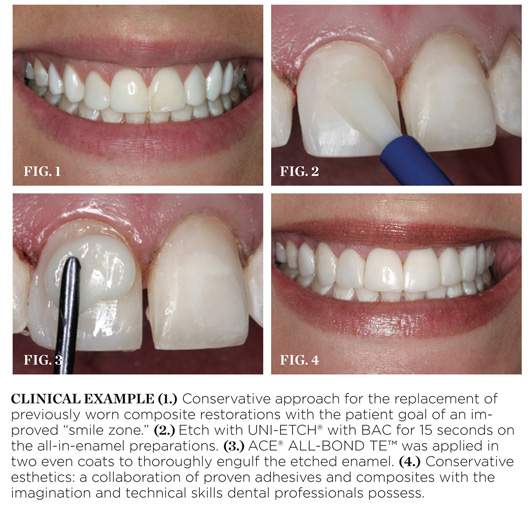ACE® ALL-BOND TE™
The only single-step/dual-cure adhesive in dentistry.
Routine excellence in delivering minimally invasive, esthetic restorative dentistry is every clinician’s goal. It requires the collaboration of proven adhesives and composites with the imagination and technical skills of the dentist. BISCO is proud to create restorative materials based on the feedback of the clinician. Our goal is to create materials that offer seamless, standardized clinical incorporation, and, in effect, can take the challenge away from material selection to allow the clinician to focus on the clinical challenge at hand.
Dental bonding agents (adhesives) have been rapidly evolving since the 1950s.1 It is now firmly regarded that the need for both total-etch, “etch-and-rinse” (fourth and fifth generations) and self-etch, “etch-and-dry” (sixth and seventh generations) are required for effective patient care. Enamel bonding is best accomplished with total-etch, whereas deep dentin sealing is effectively accomplished with self-etch technologies.2,3
The challenge to manufacturers has been to simplify the protocol selection by creating total-etch and self-etch systems that are similar, simple, and superior to previous offerings and, most importantly, are based on the decision-making process established by dentists and dental researchers by the use of evidence-based selection criteria.
Dual-cure/auto-cure labeling of adhesives depends on the incorporation of self-cure initiators placed within individual formulas. The clinical support of this labeling is that the shear bond strengths of dual-cure/auto-cure adhesives are statistically similar in either light-cure or self-cure modes. Most adhesives used in dentistry are not actually dual-cure by this definition, but dual-cure compatible (meaning they can be used with both dual-cure or self-cure composites due to the incorporation of initiators) but require light for maximum bond strengths. BISCO states that ACE® ALL-BOND TE™ is dual-cure/auto-cure in addition to being compatible with all composites. ACE® ALL-BOND TE™ is the only single-step, dual-cure adhesive in dentistry.
Responsible manufacturers define the perfect adhesive in terms of both predictable chemistry and clinical use. Predictable total-etch chemistry requires that it be self-cure/dual-cure compatible, versatile (indicated for direct and indirect procedures), have a stable shelf life and offer long-term bond durability. Clinicians demand ease of use, predictable dispensing, confidence in cure (auto-cure where possible) and finally, practical pricing.
The novel incorporation of cross-linking monomers within today’s bonding agents has allowed BISCO to significantly improve current bonding agents and “knock on the door” of the “perfect adhesive.” The addition of cross-linking monomers to adhesives began early on as a means to improve adhesive physical properties.4,5
BISCO researchers have recently completed the accumulation of 3- and 6-year microtensile data, conducted to determine/verify the importance of the incorporation of highly cross-linking monomers within ALL-BOND SE® and ALL-BOND 3®/ACE® ALL BOND TE™. The results show stable, high bond strengths with and without a resin layer. This study clearly demonstrates that the addition of highly cross-linking monomers in ALL-BOND SE® and ALL-BOND 3®/ACE® ALL BOND TE™ eliminates the need for additional resin layers to promote bond durability.
Adhesion is the Foundation of Esthetic Restorative Dentistry
BISCO continues to re-define adhesion. State of the art enamel bonding depends on total-etch adhesives.5 Traditional total-etch adhesives require multiple steps. The addition of highly cross-linking multifunctional monomers within ACE® ALL-BOND TE™ is shown to eliminate the need for the separate placement of a resin layer, which results in significant time saved for the clinician. Enhanced with highly cross-linking monomers, ACE® ALL BOND TE™, upon polymerization, creates a hydrophobic barrier that is shown to effectively eliminate or reduce water degradation. ACE® ALL BOND TE™ is dual-cure to provide confidence in difficult light-access areas, is compatible with all-composite, versatile for use in both direct and indirect dentistry, and offers simple, predictable dispensing (Figure 1, Figure 2, Figure 3, Figure 4).
Acknowledgement
Dentistry courtesy of Dr. Ross Nash.
References
1. Buoncore MG. A simple method of increasing the adhesion of acrylic filling materials to enamel surface. J Dent Res. 1955;34(6):849-853.
2. De Munck J, Van Landuyt KL, Peumans M, et al. A critical review of the durability of adhesion to tooth tissue: methods and results. J Dent Res. 2005;84(2):118-132.
3. Van Landuyta KL, Snauwaertb J, De Muncka J, et al. Systematic review of the chemical composition of contemporary dental adhesives. Biomaterials. 2007;28(26):3757-3785.
4. Van Meerbeek B, Yoshihara K, Yoshida Y, et al. State of the art of self-etch adhesives. 2010 Academy of Dental Materials.
5. Pashley DH, Tay FR, Breschic L, et al. State of the art etch-and-rinse adhesives. Dent Mater. 2011;27(1):1-16.
For more information, contact:
Bisco
Phone: 800-247-3368
Web: www.bisco.com
Disclaimer
The preceding material was provided by the manufacturer. The statements and opinions contained therein are solely those of the manufacturer and not of the editors, publisher, or the Editorial Board of Inside Dentistry.
About the Author
This article was written by Douglas J. Brown DDS, FAGD, Senior Manager Clinical Affairs, BISCO Inc., and Ross Nash DDS, FAACD, Cosmetic Dentistry of the Carolinas.








